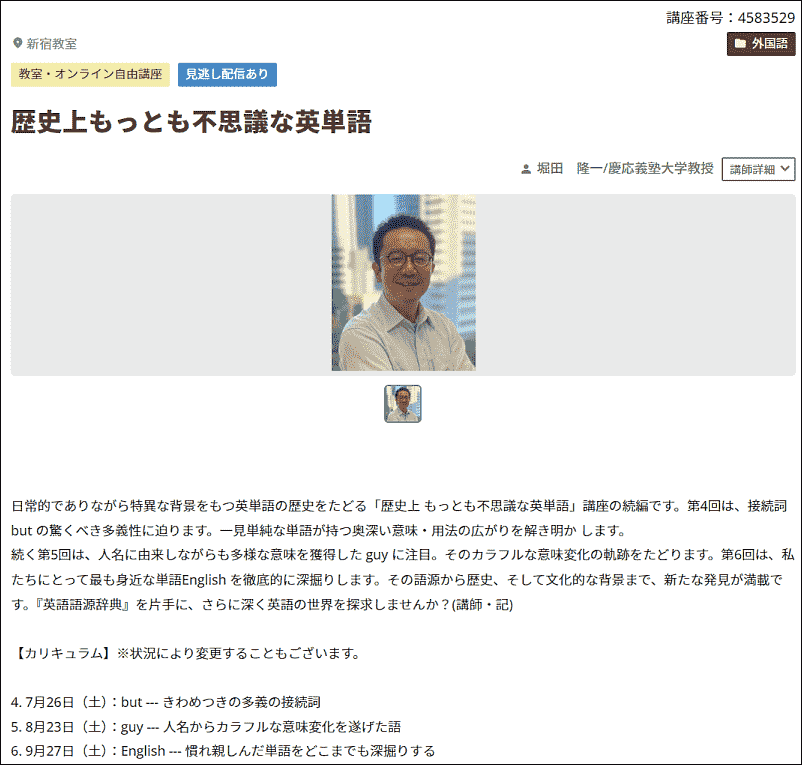最近 7 日分を以下に表示中 / 今月の一覧
2025-08-21 Thu
■ #5960. 夏スク「英語史」初日の千本ノック(前編) [senbonknock][sobokunagimon][voicy][hel_education][notice]
昨日の記事「#5959. 2025年度の夏期スクーリング「英語史」講義が始まります」 ([2025-08-20-1]) でお知らせしたように,英語史の集中講義が始まっています.昨日の講義では履修されている皆さんから「英語に関する素朴な疑問」を集め,講義後に11:30より即興で「千本ノック」 (senbonknock) の heldio 生配信を行ないました.60分超の長丁場となりましたが,立ち会っていただいた履修者の皆さん,そして急の生配信ながらもライヴでお聴き頂いたリスナーの皆さん,ありがとうございました.
生配信の様子は音声収録しておいたので,今朝の Voicy heldio にて配信しました.長尺なので前編(本日配信)と後編(後日配信)の2回に分けてお聴きいただきますが,まずは34分ほどの前編をお届けします.以下に,本編(第2チャプター)で取り上げられた質問と本編チャプター内での対応する分秒を一覧します.
(1) 01:25 --- アルファベットの起源は何か?
(2) 09:13 --- なぜ定冠詞と不定冠詞は難しいのか?
(3) 14:30 --- なぜ a は単体だと「エイ」と読むのに,単語としては「ア」と読むのか?
(4) 16:08 --- なぜ英語発祥の地であるロンドンの英語が,必ずしも標準的ではないのか?
(5) 20:28 --- なぜ英語には多くの時制があるのか?
(6) 24:36 --- なぜ発音しない文字(黙字)が入っている単語があるのか?
(7) 26:27--- 文法は現在も変化しているのか?
(8) 29:30 --- なぜ do の過去形は did なのか?
英語史の学び始めの景気づけとして「千本ノック」をやってみましたが,いかがでしたでしょうか.英語史への関心が湧いてきましたでしょうか.残暑厳しい折ですが,6日間の夏スク英語史を駆け抜けていきたいと思います.
2025-08-20 Wed
■ #5959. 2025年度の夏期スクーリング「英語史」講義が始まります [hel_education][hellog][heldio][hellog_entry_set][link][helkatsu][notice][khelf][inohota][hel_herald]
本日,慶應義塾大学通信教育課程の夏期スクーリング科目「英語史」が開講されます.来週の月曜日までの6日間にわたる集中講義です.
本日の初回講義では,本ブログの記事を組み合わせながら英語史の世界への導入を図ります.履修生の皆さんは,いつでもこちらの記事に戻ってきてください.また,この記事と同趣旨で「英語史夏期スクーリング 2025」という見やすい特設HPも用意しましたので,そちらもお気に入り等に登録してご参照ください.
1. イントロ
1.1. 不定冠詞 a と an について: 「#831. Why "an apple"?」 ([2011-08-06-1]),heldio 「#1. なぜ A pen なのに AN apple なの?」
1.2. 「英語史」講義担当者の紹介: note 「堀田隆一のプロフィール」,heldio 「#1171. 自己紹介 --- 英語史研究者の堀田隆一です」,「#2. 自己紹介」 ([2009-05-01-2])
2. 英語史の世界へようこそ
2.1. 英語史の魅力4点: 「#4546. 新学期の始まりに,英語史の学び方」 ([2021-10-07-1])
(1) 英語の見方が180度変わる
(2) 英語と歴史(社会科)がミックスした不思議な感覚の科目
(3) 素朴な疑問こそがおもしろい
(4) 現代英語に戻ってくる英語史
2.2. 「#4361. 英語史は「英語の歴史」というよりも「英語と歴史」」 ([2021-04-05-1]): 魅力 (2) に通じます
2.3. 「なぜ英語史を学ぶのか」の記事セット: 様々な角度から「なぜ学ぶのか」を検討してみました(cf. heldio 「#444. 英語史を学ぶとこんなに良いことがある!」や heldio 「#112. 英語史って何のため?」でも取り上げています)
3. 英語に関する素朴な疑問
3.1. 「#1093. 英語に関する素朴な疑問を募集」 ([2012-04-24-1]): 魅力 (3) に通じます
3.2. 3166件の素朴な疑問
3.3. これまで hellog で取り上げてきた素朴な疑問集
3.4. 知識共有サービス「Mond」で英語・言語に関する素朴な疑問に回答しています
4. 英語史を日常の風景に
4.1. 「#5097. hellog の読み方(2023年度版)」 ([2023-04-11-1]): 2009年5月1日より毎日更新している英語史のブログです.この hellog の効果的な使い方の tips をどうぞ.合わせて「#5728. 2024年 hellog でよく読まれた記事ベスト50」 ([2025-01-01-1]) もご覧ください.
4.2. 音声コンテンツ一覧 (heldio & hellog-radio): hellog の音声版というべき Voicy 「英語の語源が身につくラジオ」 (heldio) .2021年6月2日より毎朝6時に1本10--20分ほどで英語史の話題をお届けしています.日々の英語史の学びのためにフォローしてください.英語史の話題が日常になります.「#5093. heldio の聴き方(2023年度版)」 ([2023-04-07-1]),「#5727. 2024年 heldio 配信でよく聴かれた回ベスト30」 ([2024-12-31-1]),「#5098. 英語史を学び始めようと思っている方へ hellog と heldio のお薦め回一覧(2023年度版)」 ([2023-04-12-1]),「#5921. リスナー投票による heldio 2025年第2四半期のランキング」 ([2025-07-13-1]) も参照.
4.3. 「#5091. khelf の沿革,活動実績,ミッションステートメント」 ([2023-04-05-1]): khelf HP,公式 X アカウント @khelf_keio,公式 Instagram アカウント @khelf_keio より情報を発信しています.
4.4. 「#5917. 『英語史新聞』第12号が公開されました」 ([2025-07-09-1]): 世界初の英語史を主題とする新聞の第12号です.
4.5. khelf イベント2025年度版「英語史コンテンツ50」が展開中です: 今年6月20日より休日を除く毎日,英語史を専攻する通学課程のゼミ生・院生,通信課程の卒業生を中心とする khelf メンバーから手軽に読める「英語史コンテンツ」がウェブ上にアップされてきます.上記だけでは足りないという方は,過年度の同企画もどうぞ.
4.6. 「いのほた言語学チャンネル」(旧「井上逸兵・堀田隆一英語学言語学チャンネル」): 2022年2月26日より同専攻の井上逸兵先生(英語学・言語学)と一緒に週2回(水)と(日)の午後6時に動画を公開しています
5. 講義の進め方
5.1. 講義スライド(パスワード付きPDF),テキスト,リアクションペーパー提出課題,試験,評価について
5.2. 指定テキストは拙著『英語の「なぜ?」に答えるはじめての英語史』(研究社,2016年).本書のコンパニオン・サイトもあります.
5.3. 英語史の読書案内:「#5830. 英語史概説書等の書誌(2025度版)」 ([2025-04-13-1]),「#4557. 「英語史への招待:入門書10選」」 ([2021-10-18-1]),heldio 「対談 英語史の入門書」
5.4. 過年度の「英語史」履修生の言葉: 「#5939. 2025年度前期,英語史の授業を通じて何を学びましたか?」 ([2025-07-31-1]),「#5393. 2023年度,1年間の「英語史」の講義を終えて」 ([2024-02-01-1]),heldio 「#974. 1年間の「英語史」の講義を終えて --- 2023年度版」
6. 履修生よりライヴで寄せられた英語の素朴な疑問に即興で答える「千本ノック」
以上,スクーリングの1週間,そしてその後も,知的興奮に満ちた英語史ライフをお楽しみください! 関連して「#5593. 2024年度の夏期スクーリング「英語史」講義が始まります」 ([2024-08-19-1]) もどうぞ.
なぜ英語史を学ぶのか.迷ったら,まず「#444. 英語史を学ぶとこんなに良いことがある!」を.
2025-08-19 Tue
■ #5958. 大修館書店『英語教育』9月号に『英語語源ハンドブック』の書評が掲載されました [hee][notice][review]

8月12日に刊行された大修館書店の『英語教育』9月号の68頁にて,新刊書『英語語源ハンドブック』の書評が掲載されました.評者は日本大学第二中学校・高等学校教諭の黒澤隆司さんです.たいへん好意的に評していただき,共著者ともども喜んで拝読しました.
6月18日に刊行された『英語ハンドブック』の書評や感想について,ネットではすでに様々な形で上がってきていますが,専門誌の紙媒体に書評記事が掲載されるのは,ほぼ初めてといってよいと思います.
今回の書評の内容について,ここであまり詳しく紹介することはできませんが,書評タイトルとして「語彙指導の「虎の巻」に」と掲げられており,本書の最大のツボを押さえていただいたという思いでいっぱいです.書評内では,本書からの具体的な単語例とそこでの記述に言及があり,「面白い」「素晴らしい」「価値がある」とのポジティヴな言葉が並んでいます.とりわけ本書後半のテーマ別の項目や用語解説の充実振りも触れられています.最後の1節では,語彙習得への「うるおい」という印象的な表現も使われていました.あらためて,本書制作の意図を丁寧にすくい上げていただいたと感じます.
皆さんも,ぜひ『英語教育』9月号を手に取って,この書評をお読みいただければ.
今回の書評の話題は,先日の heldio でも「#1537. I と my/me/mine は補充法 --- 『英語教育』9月号に『英語語源ハンドブック』の書評が掲載されました」として取り上げました.こちらもお聴きください.
・ 黒澤 隆司 「書評:唐澤 一友・小塚 良孝・堀田 隆一(著)『英語語源ハンドブック』(研究社)」『英語教育』(大修館) 2025年9月号,2025年.68頁.
2025-08-18 Mon
■ #5957. 8月23日(土),朝カル講座の夏期クール第2回「guy --- 人名からカラフルな意味変化を遂げた語」が開講されます [asacul][notice][personal_pronoun][eponym][grammaticalisation][semantic_change][kdee][etymology][hel_education][helkatsu]

朝日カルチャーセンター新宿教室での英語史講座が続いています.月一のペースで進行中のこのシリーズでは,「歴史上もっとも不思議な英単語」というテーマを掲げています.歴史の厚みを感じさせる語彙を一語ずつじっくりと味わい,『英語語源辞典』(研究社)等の信頼できる資料を手がかりに,言葉の変遷がもたらす驚きと発見に迫っています.
今度の土曜日8月23日(土)の講座は夏期クールの2回目を迎えます.一見すると平凡な guy という語に焦点を絞り,この小さな単語がたどってきた劇的な意味の軌跡をたどることから話を始めます.その流れから人称代名詞 (personal_pronoun) の話題,文法化 (grammaticalisation) の問題,そして固有名詞に由来するeponymの事例相まで,話題は自在に広がっていきます.1単語から見えてくる英語史のダイナミズムと言語変化の妙味を存分にお楽しみください.
参加方法は新宿教室での直接受講,オンライン参加のいずれかをお選びいただけます.さらに2週間の見逃し配信サービスもご用意しております.皆さんのご都合のよい方法でご参加ください.申込み詳細は朝カルの公式ページでご確認いただけます.
なお,この講座の見どころについては heldio で「#1539. 8月23日の朝カル講座 --- guy で味わう英語史」としてお話ししています.こちらもあわせてお聴きいただければ幸いです.
・ 寺澤 芳雄(編集主幹) 『英語語源辞典』新装版 研究社,2024年.
2025-08-17 Sun
■ #5956. 100の場所で英語史を学ぶ本 --- A History of the English Language in 100 Places [notice][review][toc][hel][historiography]
ヘルメイトの ari さんが,7月11日にご自身の note 上に「#340【Review】A History of the English Language in 100 Places」と題する記事を公開されている.ari さんは「前から気になっていた本」として言及されていたが,私にとっても同じで,いつか読もうと思いつつも書棚に眠らせていた「気になる本」だった.

ランダムにパラパラと読み始めたが,すこぶるおもしろい.世界中の「場所」に注目して英語史を描くという着想は,英語史記述の方法論として卓越しているし,実際に完全に奏功しているように思われる.今後じっくり読み進めていくべく,自分のためにも目次を提示する形で100の場所を挙げておきたい.
FOREWORD BY DAVID CRYSTAL
ACKNOWLEDGEMENTS
1. INTRODUCTION
2. THE BEGINNINGS OF ENGLISH
(1) UNDLEY COMMON --- the earliest written English (c.475)
(2) CANTERBURY --- the adoption of the Roman alphabet (602)
(3) HAMMERWICH --- Mercian English, our ancestor dialect (c.700)
(4) MONKWEARMOUTH --- naming the English language (731)
(5) YORK --- the influence of Danish on the English language (866)
(6) WINCHESTER --- West Saxon English and King Alfred (871)
(7) CERNE --- Classical Old English (c.1000)
(8) HASTINGS --- the influence of French on the English language (1066)
(9) DUNFERMLINE --- the English language in Scotland (1068)
3. MIDDLE ENGLISH
(10) PETERBOROUGH --- the Anglo-Saxon Chronicle and the end of Old English (1155)
(11) READING --- the English language in popular song (c.1235)
(12) WESTMINSTER --- the recovery of the English language (1362)
(13) KILKENNY --- the English language in Ireland (1366)
(14) ALDGATE --- the development of Middle English (1374)
(15) CHANCERY STREET --- Chancery English (c.1419)
(16) ST PAUL'S CHURCHYARD --- the English language and the book trade (1456)
(17) PEMBROKE --- the English language in Wales (1457)
4. THE BEGINNINGS OF MODERNITY
(18) BRUGES --- the English language and the printing press (1474)
(19) COLOGNE --- the Bible in English (1525)
(20) PARIS --- the beginnings of punctuation in the English language (1530)
(21) CARLETON --- the influence of Latin on the English language (1531)
(22) NORTHOLT --- spelling and the Great Vowel Shift (1551)
(23) ARCHANGEL --- business English (1553)
(24) STRATFORD --- the development of Early Modern English (1564)
(25) CHICHESTER --- English grammar (1586)
(26) HAMPTON COURT --- the English language and the King James Bible (1604)
5. THE BEGINNINGS OF WORLD ENGLISH
(27) JAMESTOWN --- the English language in the Americas (1607)
(28) HAMILTON --- the English language in the West Indies (1609)
(29) THE MERMAID TAVERN --- the refining of English punctuation (1623)
(30) SALISBURY --- the English language and the language of the law (1631)
(31) HOLBORN --- making English the language of science (1660)
(32) TRINITY COLLEGE --- English proverbs (1670)
(33) PHILADELPHIA --- the development of Midland American English (1682)
(34) NÎMES --- using place names to make up new words (1695)
(35) BOSTON --- the development of New England English (1704)
6. THE STANDARDS AGENDA
(36) LICHFIELD --- setting standards for the English language (1709)
(37) TEMPLE --- the idea of an English Language Academy (1712)
(38) CANONGATE --- British spelling (1760)
(39) SMOCK ALLEY --- English elocution (1762)
(40) MONTREAL --- the English language in Canada (1763)
(41) KEW GARDENS --- botanical English (1771)
(42) KOLKATA --- the birth of linguistics and the origins of English (1786)
(43) MARYLEBONE --- the language of sport (1788)
(44) SYDNEY --- the English language in Australia (1788)
(45) ST MARY-LE-BOW --- Cockney English (1803)
(46) COUPVRAY --- the English language in Braille (1809)
(47) MONROVIA --- the English language in West Africa (1822)
7. THE INDUSTRIAL AGE
(48) STOCKTON-ON-TEES --- the English language and the steam engine (1825)
(49) HARTFORD --- establishing an American standard for English (1828)
(50) CHENNAI --- the English language in India (1834)
(51) ST MARTIN-LE-GRAND --- the English language and the Uniform Penny Post (1840)
(52) WAITANGI --- the English language in New Zealand (1840)
(53) THE STRAND --- English as a language of satire (1841)
(54) BALTIMORE --- the English language and the telegram (1844)
(55) SALFORD --- literacy and free libraries (1850)
(56) HANNIBAL --- English comic writing (1851)
(57) HYDE PARK --- industrialization and its impact on English (1851)
(58) TIMES SQUARE --- The New York Times (1851)
(59) MANCHESTER --- the vocabulary of English and the thesaurus (1852)
(60) BERDICHEV --- exophonic English (1857)
(61) CHRISTCHURCH COLLEGE --- English nonsense (1865)
(62) LLANFAIRPWLLGWYNGYLL --- English place names (1868)
(63) EXETER PLACE --- the English language and the telephone (1876)
(64) CAPE TOWN --- the English language in South Africa (1881)
(65) DUBLIN --- extreme English (1882)
(66) GISBORNE --- English slang (1894)
8. THE TWENTIETH CENTURY
(67) POLDHU --- the English language and the radio (1901)
(68) NEWGATE --- the English language and prison patter (1902)
(69) NEW ORLEANS --- African American English (1902)
(70) FLEET STREET --- tabloid English (1903)
(71) NEW YORK --- the language of crosswords (1913)
(72) HAYMARKET --- rule English (1914)
(73) GUERNSEY --- modern English usage (1926)
(74) PORTLAND PLACE --- BBC English (1926)
(75) OXFORD --- the Oxford English Dictionary (1928)
(76) BLETCHLEY PARK --- English language and code (1939)
(77) EMPIRE STATE BUILDING --- the language of advertising (1941)
(78) ISLINGTON --- plain English (1946)
(79) ETON --- the English of the English upper class (1956)
(80) LIVERPOOL --- British urban English (1963)
(81) ATLANTIC CITY --- sexist English (1968)
9. THE TECHNOLOGICAL REVOLUTION
(82) SEA OF TRANQUILLITY --- English on the moon (1969)
(83) LOS ANGELES --- the language of e-mail (1969)
(84) BELMOPAN --- the English language in Belize (1970)
(85) ST PANCRAS --- the British Library (1973)
(86) ISLAMABAD --- the English language in Pakistan (1973)
(87) THE BRONX --- language of rap (1973)
(88) SAN JOSE --- the English language and text preservation (1975)
(89) SINGAPORE --- English in Singapore (1987)
(90) GENEVA --- the language of the World Wide Web (1991)
(91) HELSINKI --- the English language and texting (1993)
(92) SWARTHMORE --- the language of the blog (1994)
(93) NICHOLSON STREET --- global reading phenomenon (1995)
(94) WINDRUSH SQUARE --- multicultural London English (1998)
(95) SAN FRANCISCO --- Twitter English (2006)
(96) BEVERLY HILLS --- Teen Speak (2008)
(97) KIGALI --- English as an official language (2008)
(98) NEWCASTLE --- the English language and contemporary regional accents (2011)
(99) BEIJING --- English and Mandarin (2012)
(100) VIENNA --- English as a global lingua franca (2012)
10. AFTERWORD
REFERENCES
BIBLIOGRAPHY
狙いが素晴らしい.これから hellog でも折に触れて参照していきたい.
・ Lucas, Bill and Christopher Mulvey. A History of the English Language in 100 Places. London: Robert Hale, 2013.
2025-08-16 Sat
■ #5955. ZIP-FM の「Limelight」に小塚良孝さんがゲスト出演 --- 『英語語源ハンドブック』について語っています [notice][hee][grimms_law]

1ヶ月ほど前のことになりますが,7月19日(土)22:30-23:30 に ZIP-FM のラジオ番組,パーソナリティの鉄平さんによる「Limelight」
「Limelight~来夢来人~(ライムライト)」に,新刊書『英語語源ハンドブック』の著者の1人,小塚良孝さん(愛知教育大学)がゲスト出演されました.
その出演回が,後日 Podcast としても配信されました.上記チャンネルの「#120 小塚良孝」として聴くことができるので,ぜひ訪れてみてください.43分ほどの番組です.
6月18日に刊行され,すでに重版も出ている『英語語源ハンドブック』に関する話題はもちろん,英語史に関する一般的な話題も豊富で勉強になります.2人の軽快なトークも必聴です.以下に,私の視点からトークの流れをまとめます.
【新刊紹介】
『英語語源ハンドブック』は,英語の語源をテーマにした本としては珍しく,英語史の専門家3人がタッグを組んで書いたものです.これまで,こうした語源の本は,専門家ではない人が一般向けに書くケースが多かったのですが,今回は専門知識と正確な情報に基づきつつ,それでいて読み物として楽しめるよう工夫されています.小塚さんによれば「辞書ほど堅くなりすぎず,でも専門的な裏付けもしっかり」というバランスがポイントだったとのこと.
【語源記述に頻出する「グリムの法則」】
ハンドブックの中から具体的な話題が紹介されました.その1つが「グリムの法則」 (grimms_law) です.童話で有名なグリム兄弟の兄がまとめたもので,ヨーロッパの言語の中でもゲルマン語派(英語・ドイツ語・オランダ語など)だけに見られる音の変化を説明する法則です.例えば,「歯」を意味する英語 tooth は,ラテン語やフランス語では dent- などとなります.語頭の /t/ と /d/ の関係のように,ある音が別の音に規則的に対応するパターンがあり,それを理解すると英語と他の言語のつながりが見えてきます.鉄平さんも「へぇ」と感心しながら聞き入っていましたね.
【英語は借り物だらけ】
会話はさらに,英語が多くの単語を外から借りてきた歴史へと広がります.ラテン語やフランス語からの借用はもちろん,日本語からの借用も意外と多く,kawaii などの単語は最近英語でもよく目にします.とりわけフランス語から多くの語が入った背景には,イングランドがフランスの支配下にあった中世の歴史が関係していることにも触れられました.
【本作りの裏話し】
本の執筆の過程で苦労した点として,小塚さんは「意味も形もほとんど変化していない単語」が書きづらかった述べていました.語源をたどっても変化が乏しい単語は,書き手としては話を広げにくく,キャッチコピーも「ほとんど使い方が変わっていない語」などとせざるを得ない場合もあったそうです.一方,animation の項目のように,意外な語源的つながりがあり,おもしろく書ける例もあったとのことです.この単語の源はラテン語 animāre 「命を吹き込む」にあり,animal 「動物」とも語源的関係にあります.
【wild の語源は「森」だった】
もう1つの注目すべき例として取り上げられたのが wild です(なぜ注目されたのでしょうか?).今では「荒々しい,野生の」といった意味で使われますが,語源をたどると古英語 weald 「森」に遡ります.自然や森のイメージが元になっていることが分かります.
【スギちゃんとの意外な縁】
トークは語源の話から小塚さんの経歴へ.なんと幼稚園からの友人はお笑い芸人のスギちゃん.若い頃にはスギちゃんとコンビを組み,吉本のオーディションを受けたこともあるそうです.その翌日のスポーツ新聞に写真が載ったほどインパクトがあったとか.最終的には小塚さんが学業を選び,スギちゃんは1人でお笑いの道へ.2010年代に「ワイルドだろぉ?」でブレイクしたときには,小塚さんもたいへん驚いたそうです.
【古英語研究への道】
英語史との出会いは大学時代.英語・ドイツ語・フランス語を学ぶ中で英語の歴史に魅力を感じ,指導教員から「歴史をやるなら一番古い時代から」と勧められ,古英語研究を始めたとのこと.古英語期には北欧のヴァイキングがイングランドに攻め込み,take のような日常的な単語もこの時代に北欧語から入ってきました.
【音楽と英語】
中学時代,ビートルズに夢中になったことも英語好きのきっかけとなりました.アルバムを何度も聴き込み,歌詞に触れる中で自然と英語に親しむようになったとのこと.思い出の曲として「Let It Be」を挙げています.
【これからの研究と夢】
今後の研究については,AI やプログラミングを使って文学作品中の音のパターンを自動抽出するソフトを仲間とともに開発中だといいます.人間の目では拾いきれないデータを効率的に分析し,研究の幅を広げるという狙いです.一方,プライベートでは農業やクラフトビール造りに力を入れていきたいとのこと.自家製の野菜や果物を使った料理と自家醸造のビールを楽しめるパブを作り,店内には本も置いて「飲みながら読める」空間にするのが夢だそうです.
【若い人へのメッセージ】
最後に,これから英語史や英語語源研究を志す若い人へ「素朴な疑問や関心を大事にしてほしい」とのメッセージ.すぐに成果が出る学問ではないからこそ,「なぜ?」と思った気持ちを大切にし,学びを続けてほしいと語りました.
番組は終始,英語史の深い話と軽快な雑談が入り混じり,リスナーとしても肩の力を抜いて楽しめる内容になっていました.小塚さん,『英語語源ハンドブック』の広報を,そして私も初めて聞くような魅力的なお話を,ありがとうございました!
・ 唐澤 一友・小塚 良孝・堀田 隆一(著),福田 一貴・小河 舜(校閲協力) 『英語語源ハンドブック』 研究社,2025年.
2025-08-15 Fri
■ #5954. 「子供」を意味する古英語 bearn,現代スコットランド方言の bairn について --- ykagata さんのブログ記事より [hee][german][dialectology][oe][scots_english][germanic]

ヘルメイトの ykagata さんが,HatenaBlog 上で展開しているブログ 「blog.heartyfluid --- 勉強したることども」にて,「『英語語源ハンドブック』にこじつけて学ぶドイツ語」と題する魅力的なシリーズを始められている.昨日までに『英語語源ハンドブック』より a/an, baby, cake, dad/daddy, each を取り上げた5つの記事が公開されており,A to Z にかける野心が感じられる.(応援しています!)
8月11日に投稿されたシリーズ第2弾「『英語語源ハンドブック』にこじつけて学ぶドイツ語 #2 baby」より,英単語 baby の他言語への展開の様子をおもしろく読んでいたが,「余談:ゲルマン祖語 *barną 「赤ちゃん」について」の1節に目が留まった.「赤ちゃん」から転じて「子供」を意味するようになった単語として,*barną 系列のものは,現代標準ドイツ語では残っていないという.そこでは,むしろ *kinþą 系の Kind が早くから一般化したとのことだ.ところが,南ドイツ・オーストリア・スイスの一部方言では,*barną 系列の Bua (少年)や Bar/Bärn (子)が用いられているという.
英語史を学んでいると,ここでピンとくる.古英語で「子供;子孫」を意味する頻出語で中性名詞の bearn のことだ.OED によると,この語は中英語では主に barn として存続した(この語形には古ノルド語の同根語が関与している可能性がある)が,後の標準英語にはほとんど残らなかった.しかし,スコットランドでは bairn の形で歴史を通じて使用され続け,現代でも普通に用いられている.標準英語でも1700年以来,文学語として bairn がときに見られるが,これはスコットランド語法の借用と解釈するのがよさそうだ.
ドイツ語においても英語においても,「子供」を意味する類義語間の選択が,方言に応じて割れているというのがおもしろい.動物語や遊びの言葉など,子供が日常的に好むものの名前には方言差が出やすいとされるが,「子供」という語そのものにも類似した傾向があるのだろうか.
| このページへのアクセス数 | |
| 最終更新時間 | 2025-08-21 08:44 |
Copyright (c) Ryuichi Hotta, 2009--

















